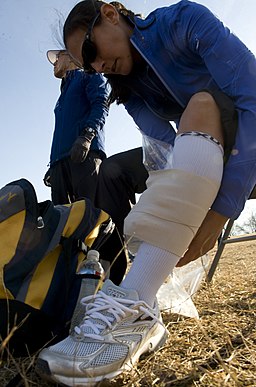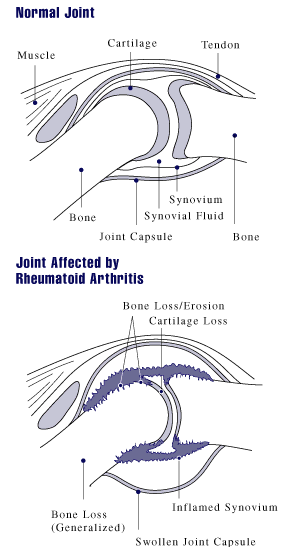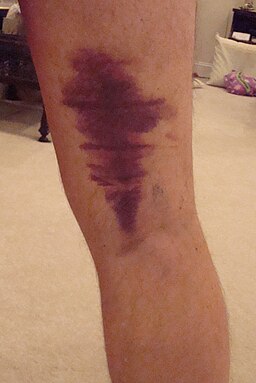 Leg pain refers to any kind of pain that occurs
Leg pain refers to any kind of pain that occurs between the heels and the pelvis. There are many reasons for leg pain, and not
all of them are caused by a problem that originates in the leg; some injuries or
spinal problems can cause aches and pains in the leg(s).
Leg pain can be long-term, transitory, intermittent, acute, or slowly
progressive. Pain may affect just part of the leg, such as the knee, or the
whole limb. Leg pain may be felt as tingling, sharp, dull, an ache, or a
stabbing sensation.
Some leg pains may be just a nuisance, in some cases the cause may never be
found, other leg pains may be a sign of a more serious disease or condition,
even a life-threatening one.
Leg pain caused by trauma
Trauma has a
medical and psychiatric meaning. In this text, it refers to the medical meaning.
Trauma is a serious injury, wound or shock, and can include broken bones, damage
to bones, damage to muscles, joint injury, or a combination.
Even trauma to the back, if the sciatic nerve becomes inflamed, can cause
pain that makes its way down the leg along the sciatic nerve (sciatica).
Overusing some part of the leg can also lead to injuries.
 Fractures - fracture refers to any kind of break in
Fractures - fracture refers to any kind of break in bone, and sometimes cartilage. Not all bone fractures are caused by trauma -
patients with osteoporosis may have such weak bones that they fracture with the
minimum of pressure. Fractures are common causes of leg pain, and occur when
nerve endings in the tissue that surround the bone (periosteum) send pain
messages to the brain. Sometimes, a bone fracture can cause muscles to spasm,
which further exacerbates the pain.
Shin splints -
medically known as medial tibial stress syndrome, refers to pain just behind the
tibia (shinbone) or along it. Shin splints occur when too much force bears down
on the shinbone and connective tissue that connect muscle to the bone. Runners
and those who take part in stop-start activities, such as squash, tennis, soccer
or basketball are more likely to suffer from shin splints. Symptoms may include
soreness, pain or tenderness, and sometimes mild swelling in the affected
area.
Strains and/or
sprains - strains are injuries to tendons or muscles, while
sprains are injuries to ligaments. Strains occur when you tear, twist, or pull a
muscle. People with a sprain commonly experience acute pain, weakness and muscle
spasms. Sprains usually occur as a result of trauma, such as a fall. The area
may bruise and the pain can be intense, especially when moving.
Compartment syndrome
- this is when an increase in pressure and swelling affects a compartment
(limited space); the blood vessels, nerves and possibly also the tendons that
run through the compartment are affected. Symptoms typically include tingling,
numbness, sometimes severe pain, as well as loss of movement in a foot.
Eventually, in time, the nerve can become compressed, there may be paralysis,
contracture, and even death.
Bleeding - an injury
to the leg that causes internal bleeding can lead to pain. A build-up of blood
can press against tissue, bone and nerve endings. Blood itself is irritating,
and can cause inflammation, which is painful.
Other causes of leg
painPeripheral artery disease (PAD), also known as
peripheral arterial disease, or peripheral artery occlusive disease, refers to
blockages in large arteries which are not located within the brain, coronary, or
aortic arch vasculature. PAD can be caused by atherosclerosis, an embolism or
thrombus, or any inflammatory process that leads to stenosis (narrowing of a
blood vessel).
Put simply, the blood vessels to the leg become narrower, restricting the
blood supply. Pain is felt with physical activity. Pain, weakness, numbness, or
cramping in muscles caused by decreased blood flow is known as claudication.
Leg pain caused by arterial disease
and exercise - if a patient's leg pain is caused by arterial
disease, they may be able to skip treatment of the affected artery if they
participate in a hospital-supervised exercise program, researchers at Erasmus
MC, University Medical Center in Rotterdam, the Netherlands, reported in
Radiology (February 2009 issue).
Some people with peripheral arterial disease suffer from a painful leg
condition called intermittent claudication. Various treatment options are
possible, including endovascular revascularization or drug therapy.
Lead author, Sandra Spronk, Ph.D., said:
"The results from our clinical trial
demonstrate that after six and 12 months, patients with intermittent
claudication benefited equally from either revascularization or supervised
exercise."
Poor blood supply can lead to several complications, such as ulcers,
which can be very painful. (Read the "David Dow" story further down)
Deep vein thrombosis - also known as DVT occurs when a thrombus (blood clot) develops
in a deep vein, nearly always in a leg. The clot tends to occur in leg veins,
such as the femoral or popliteal veins, but can also develop within the pelvis.
The thrombus can break off and make its way to the lung, causing a pulmonary
embolism.
Some patients may have a DVT and not be aware of it; there are no symptoms.
If symptoms do emerge, they will include swelling, pain, tenderness, and warmth
in the affected area. Usually, the pain starts in the calf. In some cases the
skin may go red, especially at the back of the leg below the knee. Surface veins
may become engorged.
Sciatica - this
occurs when the sciatic nerve is irritated. Pain radiates from the lower back,
all the way down to below the knee, via behind the thigh and buttocks. Sciatica
can have a number of causes, such as a herniated disc that presses directly on
the nerve. The pain, which can be severe, is sometimes accompanied by numbness,
muscular weakness, tingling and problems controlling or moving the leg. When the
weather is very cold, pain may become worse.
Peripheral neuropathy - refers to a problem with function of nerves outside the spinal
column, such as in the legs. Symptoms include burning pain (especially when
lying down), problem with reflexes, numbness, pins and needles, and weakness.
Peripheral neuropathy can be caused by certain medications, kidney failure,
vitamin deficiency, and diabetes.
In severe cases, the patient's feet can become too sensitive to touch (even
lightly touching the skin hurts). Eventually, the patient may become housebound
if shoes and socks cannot be worn and the feet are too sensitive to touch the
ground (extreme cases).
Diabetes - patients
with diabetes have a higher risk of experiencing leg and/or foot pain - these
are due to diabetes complications, such as peripheral neuropathy or some
vascular problem that results in poor blood circulation.
Alcoholism - excessive alcohol can have a damaging effect on the brain,
peripheral nerves and muscles. Common symptoms linked to alcoholism include (in
the leg) burning pain, tingling, muscle weakness, sensitivity to heat, and
tingling.
Cancer - the most
common symptom of bone cancer is pain. Other cancers, such as prostate cancer
that has spread (metastasized), may also cause pain in the pelvic area and upper
leg area. Ovarian or cervical cancer may also cause leg pain.
Shingles - symptoms
of shingles include pain in various parts of the body, including the legs.
Arthritis - affects
the musculoskeletal system, especially the joints. Arthritis is the main cause
of disability among individuals aged over 55 years in wealthy nations. It is not
a single disease, but a term that covers over 100 medical conditions, of which
osteoarthritis is the most common.
 Rheumatoid arthritis
Rheumatoid arthritis joint
Osteoarthritis - the cartilage loses elasticity,
becomes stiff and consequently damages more easily. The cartilage will gradually
wear away in some areas, causing tendons and ligaments to become stretched,
resulting in pain. Joints in the leg may start rubbing against each other,
causing intense pain.
Rheumatoid arthritis - this is a
form of arthritis with inflammation. The synovium (synovial membrane) is
attacked, causing swelling and pain. Symptoms can come and go, and may include
stiffness, swelling, and pain in the joints.
Infectious
arthritis (sebptic arthritis) - the synovial fluid and tissues of a joint become
infected; usually by bacteria, but possibly by a virus or fungus. The pathogen
spreads through the bloodstream of nearby infected tissue, and infects a joint.
The patient may experience chills, general weakness, fever, problems moving the
limb, severe pain in the infected joint, especially when trying to move. The
joint will also swell and feel warm.
Myalgia - muscle
pain. This could be caused by an infection, overusing or overstretching a muscle
or group of muscles. Sometimes it is a symptom of chronic fatigue syndrome.
Muscle cramps - these
may be extremely painful and can have many causes, such as not stretching
properly, an electrolyte imbalance, exposure to large changes in temperature, or
dehydration.
Hamstring injury -
this occurs when one of the hamstring muscles is pulled or strained. Hamstring
muscles run along the back of the thigh. In some cases, the muscle tears
completely or partially. The patient may feel a sharp, sudden pain in the back
of the thigh during physical activity. Some describe it as a tearing or popping
sensation. A few hours after the injury, there may be some tenderness or
swelling, as well as bruising.

The story of David Dow and his leg
pains
David Dow thought his leg pains were due to a back
problem. As you will read further on, the pain actually saved his life. David
was a seemingly healthy male, aged 57. He suspected nothing serious, and thought
that perhaps some back-strengthening exercises with a personal trainer would be
good for him.
Workouts were done perfectly, and his back got stronger. However, the leg
pain just got worse - so much so, that eventually it became a struggle to make
it from his car to the grocery store entrance. David, and also his trainer
wondered whether there might be something more serious going on.
He saw his doctor, who ordered some diagnostic tests. It turned out that he
had blockages in the blood vessels in his legs. He was astonished to discover
that the arteries that went to his lower extremities were almost 100% blocked.
Why? The doctor told him that after years of regular smoking, consuming meals
high in animal fats, and some other factors, cholesterol, scar tissue, and blood
clots accumulated inside the blood vessels.
Most lay people do not associate clogged artery disease and/or
arteriosclerosis with the legs, but rather the heart. In David's case, this was
developing all over his body - he had PAD (peripheral arterial disease).
PAD can cause leg pain. In fact, experts say it is an "early warning" that a
heart attack or stroke is looming.
James Stanley, M.D., a director of the University of Michigan CVC, and the
vascular surgeon who operated on David, said:
"This is the hallmark of a disease
that's all over. It's like gray hair you don't just get it on one side of your
head. So if you've got this kind of blockage in your leg, you're going to have
it other places."
Dr. Stanley explained that almost one quarter of those with
PAD-associated leg pain die within five years, mainly from a heart attack or
some other heart problem. Those with David's symptoms - hardly able to walk to
the shop from his car - are even more likely to die within five years.
David was lucky. He was diagnosed and treated in time. He has a bypass
operation to open his blocked leg arteries. His doctor says he is fine now.
David said:
"For sure, it's a wake-up call. You
know that old saying, 'Where there's smoke, there's fire'? I'm sure that I not
only have the vascular issues in my lower extremities, but I'm sure I have them
in other parts of my body."
David gave up smoking and has adopted some urgently needed lifestyle
changes.
Dr. Stanley explained that nearly 30 million Americans have some kind of PAD,
and most of them without any symptoms. Nearly one in every five 70 year-old
American has PAD.


